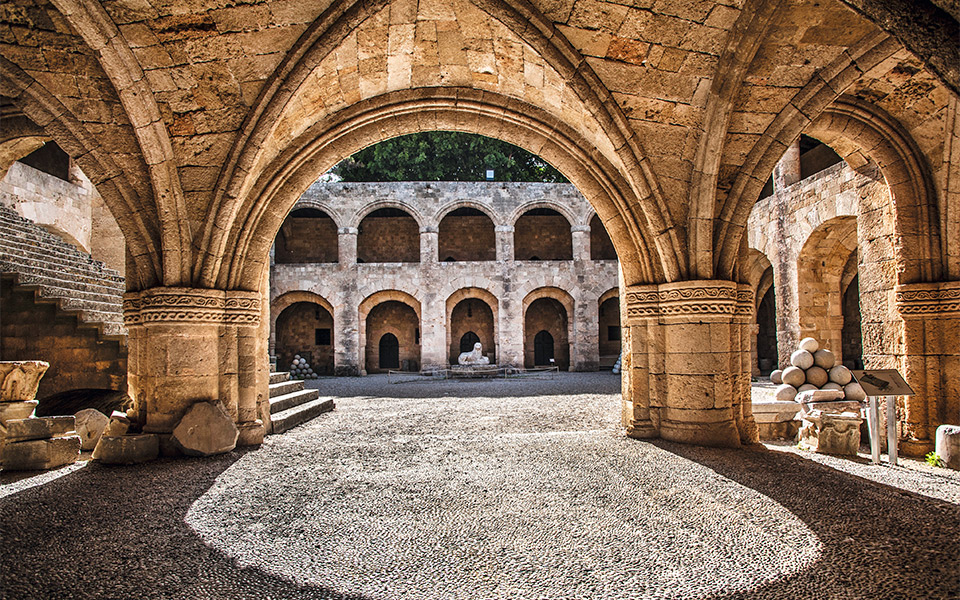Τime is locked out. Everyone else is within: ancient Greeks, Byzantines, Ottomans, Jews and Italians. This is, however, the romantic view; in truth, they are not alone, these wonderful ghosts. With them are tourists in their thousands, archaeologists, tour guides, artists, permanent residents, business people and touts, all continuing to write the history of the Old Town of Rhodes, a story which has been unfolding for the past 2,400 years.
And this is why I approach those mighty walls, four kilometers long, with some trepidation about what I will find. How harmoniously does the glorious and intriguing past coexist with the intensely tourism-oriented present? The monumental with the commercial? The Old Town’s designation as a UNESCO World Heritage Site (assigned in 1988) with the mass nature of a global brand name in tourism which was already being developed as early as the 1950s?
At any rate, these are my thoughts as I pass through Liberty Gate, one of the 11 gates affording access to the Old Town and the first that you encounter when coming from the harbor of Mandraki. It’s early in the morning, and I’ve already checked that there are no cruise ships in the harbor; otherwise I would see nothing but people.
My first impression is one of awe. I suddenly find myself in a time of knights: only porous sandstone and cobbled streets as far as the eye can see. It is not easy to absorb this. You have the feeling that if you take a few more steps, you’ll see modern buildings, ugly ones perhaps, or at least something completely out of place. Or that gently pushing a wall will result in its collapse, as if it were some flimsy film set at Cinecittà – especially knowing that the Italians, too, have left their mark here.
After they seized the island from the Turks in 1912, they saw themselves as successors to the knights and set about restoring or reconstructing many of the medieval buildings. But have no fear, no wall will collapse and there is nothing ugly, at least not in the northern part known as the Kollakio, or Knights’ Quarter.
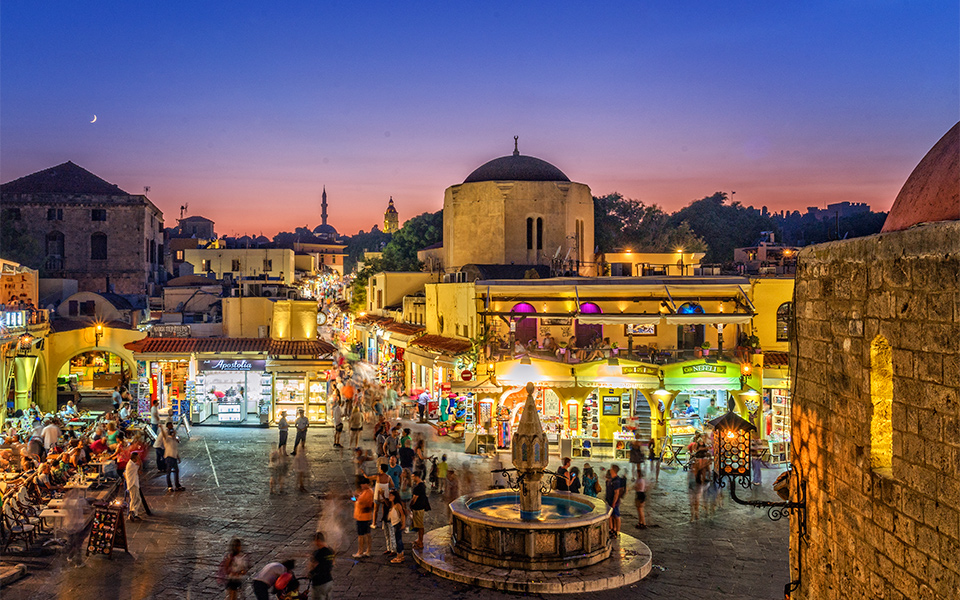
© Perikles Merakos
The Knights Hospitaller of St. John captured Rhodes in 1309. In the Old Town, where they established their administrative center, there was already a fortified Byzantine settlement occupying 175,000 square meters which had been built on the site of an ancient city that dated back to 408 BC.
The Knights expanded the area of the town to 420,000 square meters and protected it with three lines of defensive fortifications. This was also how they handed it over to the Ottomans, after a long siege in 1522. The new rulers made only slight alterations to the fortifications but changed the use and form of the buildings, converting some churches into mosques.
When the Italians occupied Rhodes in 1912, they restored the Knights’ Quarter to its former state. This area, named Kollakio, accounted for one-third of the old city. The remaining part, known as the Bourgo, was where the common people lived.
The amalgam resulting from the coexistence and the exchange of different populations over the centuries is what makes the Old Town of Rhodes unique. “You don’t really need a guide here. Even if you haven’t read anything, even if no one has explained anything, you can see the history all around. Like an illustrated children’s book,” says Aikaterini Gogou, president of the Association of Qualified Tourist Guides of the Dodecanese.
And the truth is that, in just one block, you can see: ancient ruins; a Byzantine church; an Ottoman mosque; and a plaque honoring the Fascist leader Mussolini. “Everything is part of the history of Rhodes. And we must respect everything. For instance, some visitors become angry when they see the plaque. But this, too, is a piece of Rhodes. The squares you see today are the results of German bombardments; they weren’t there before,” Aikaterini explains.
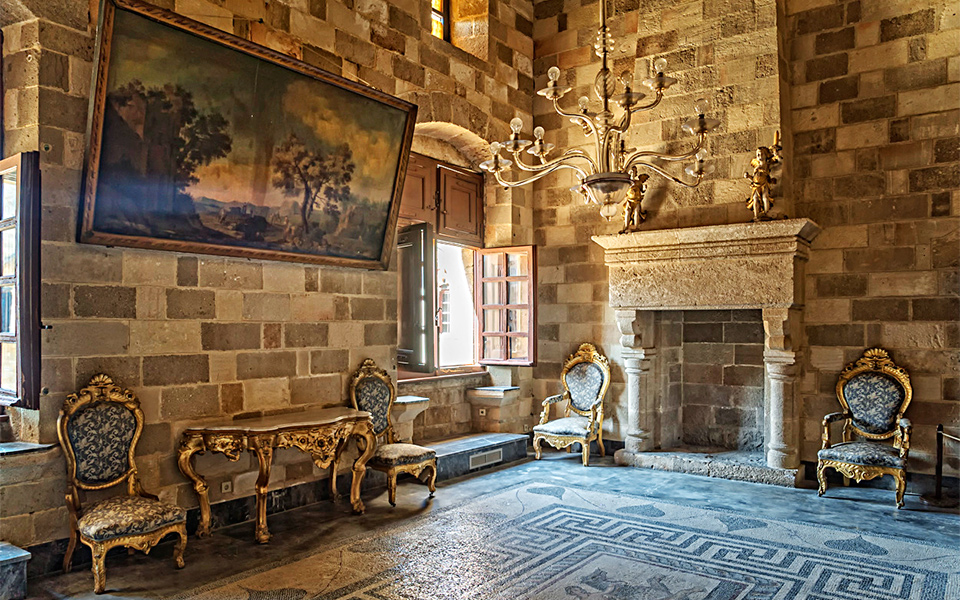
© Perikles Merakos
THE KNIGHTS’ QUARTER
After entering through the Liberty Gate, you get the first hint of what a palimpsest the Old Town is in Symi Square and Argyrokastrou Square next to it. In just a small radius are the ruins of a Temple of Aphrodite, a preserved section of Hellenistic fortifications, the 11th-century Church of Our Lady of the Castle, the old arsenal of the Knights (which houses a fine collection of folk art) and the Municipal Art Gallery. A little further on is the Mansion of Hassan Bey and the Inn of the “Tongue” of Auvergne, in the beautiful garden of which there is a café.
The inns were where the Knights gathered, each one corresponding to the language (“tongue”) they spoke. Most are located on the celebrated Street of the Knights, which begins here, next to Museum Square and the Arnaldo Gate.
A jewelry store, clothes and souvenir shops and a bank are housed in medieval buildings. A group of street artists have set up their easels. Two young wandering musicians rehearse, seated on the steps next to the Archaeological Museum – the former Hospital of the Knights. There, you simply don’t know what to admire the most – the building itself, with its impressive two-story gallery and spacious inner courtyard, or the marvelous Hellenistic sculptures on display inside.
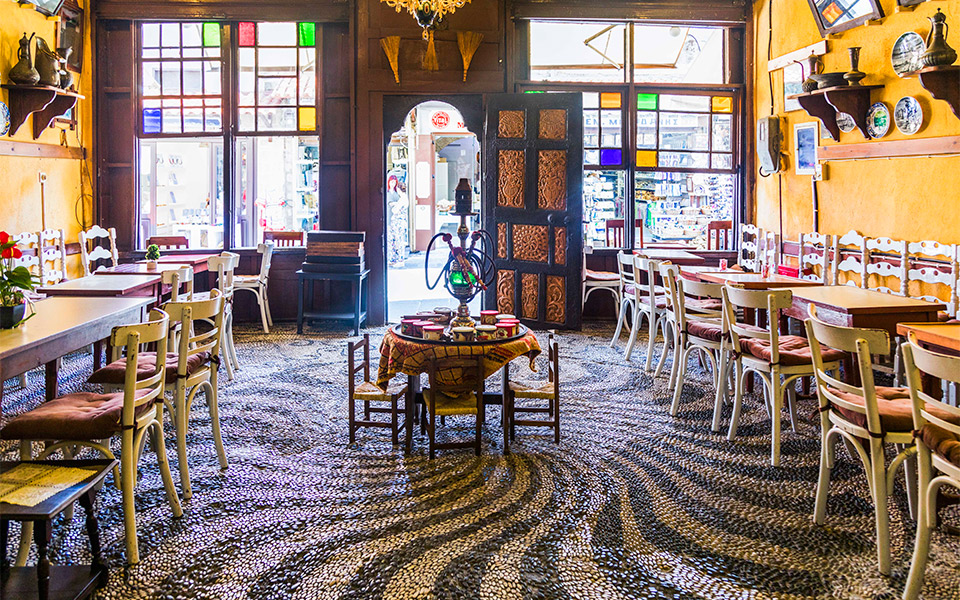
© Perikles Merakos
Fully immersed in the atmosphere, I am now walking along the cobblestoned Street of the Knights, which has remained unchanged for centuries. Most of the buildings house offices of the archaeological service or serve as homes for archaeologists and employees of the ephorate of antiquities, the only people with the right to live here. As a result, visitors can’t see the interiors, except for that of the Inn of the “Tongue” of France, which houses the French Consulate and on occasion hosts cultural events.
I observe the blazons, the architectural details on the façades, the statue of the Virgin Mary in the 14th-century Church of the Holy Trinity, and I feel that an unwritten law imposes silence and discretion. Those around me probably feel the same thing; you could hear a pin drop. Until, that is, the sound of a car abruptly shatters the enchantment, even though no vehicles are allowed in the Old Town. The law, however, has never been enforced for the permanent residents.
The Street of the Knights ends at the Palace of the Grand Master, which served as the Knights’ administrative center. Much of the edifice was rebuilt by the Italians who, some say, made it even more impressive. I enter high-ceilinged halls with period furniture and chandeliers as well as enormous fireplaces featuring coats of arms. I walk on mosaic floors dating back to the Hellenistic period, which the Italians brought from Kos. When I emerge into the courtyard, I feel somewhat disoriented, both in time and space.
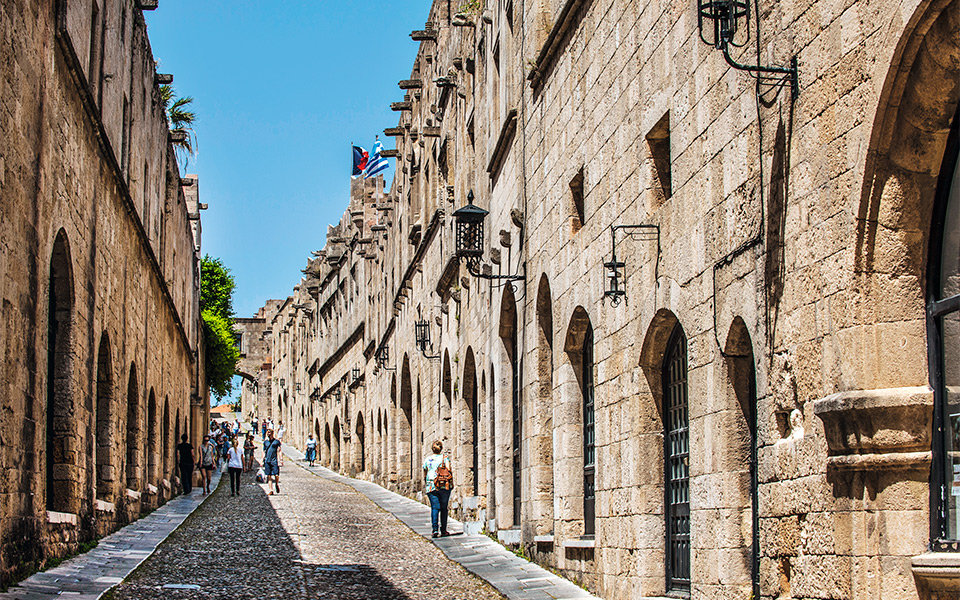
© Clairy Moustafellou
A good way to return to the present is to stroll atop the walls. The walk begins in the Palace courtyard but is permitted only between 12:00 and 15:00; that is to say, at the worst possible time, when the Rhodian sun can be merciless. After 30-40 minutes, you reach the Red Gate to the south of the town. Along the way, you’ll be rewarded with a view over parts of the new town and the sea, too.
Another way to come back to the here and now is to leave the Old Town via the exquisite D’Amboise Gate, taking in the formidable bastions or, even better, walking down in the medieval moat, which has been turned into an attractive park much loved by locals. There, on the “border” between old and new Rhodes, children and dogs play freely, peddlers set up stalls, cyclists enjoy a ride and street artists sing or paint. At the park stands the aptly named “Medieval Moat Theater,” which hosts marvelous performances in summer.
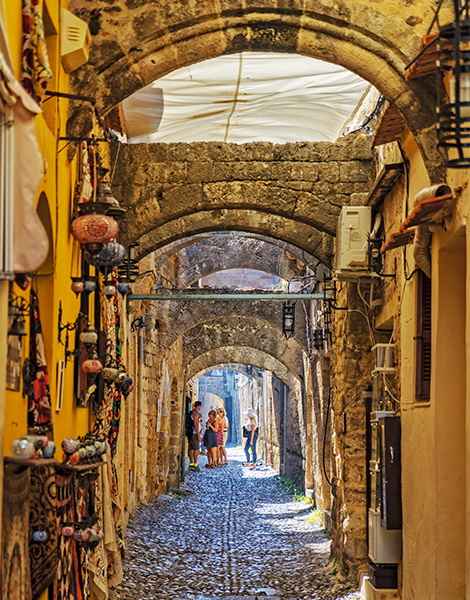
© Perikles Merakos
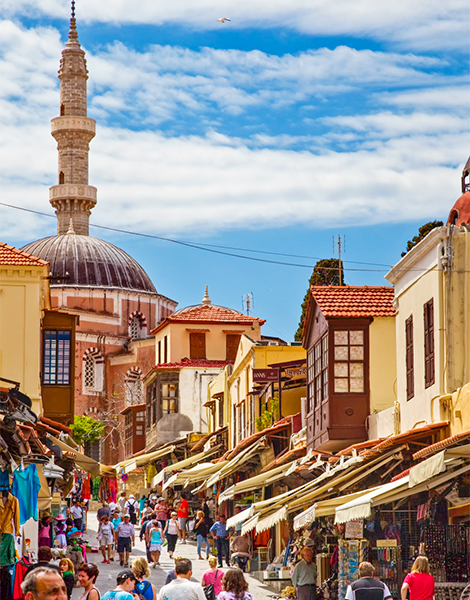
© Perikles Merakos
THE BOURGO
From the Palace of the Grand Master, you can continue in a southerly direction along Orfeos Street or Panetiou Street and enter the area known as the Bourgo, which was separated from the Kollakio by a pre-existing Byzantine wall. Initially, this was the area inhabited by Greeks, but during the period of Ottoman rule, it was Jews and Turks who lived here – the Greeks, who were expelled from the Old Town, founded Mandraki. Later, they all coexisted here, just as they do today.
About 2,000 people reside within the walls, including many Rhodian Muslims. It is estimated that a further 6,000 work here during the summer. I wander along the alleyways, spotting sections of the Byzantine wall as well as humble homes with sachnisia (overhanging enclosed wooden balconies), small porticos, arches and hidden courtyards. These narrow walkways are full of fragrances, colors and sounds.
The imposing Suleymaniye Mosque, originally built in 1522 and reconstructed in 1808, suddenly comes into view and takes my breath away. I enter the Muslim Library just opposite and gaze at Arabic and Ottoman manuscripts, unable to understand a word. Next door is the Clock Tower, built by Fethi Pasha in the mid-19th century. The tower now houses a café and for €5 you can enjoy a coffee and climb to the top, where you can see the Kollakio and Palace on one side and the Bourgo on the other, as well as the walls by the harbor and the sea beyond it all; it is a panorama not easily forgotten.
Today, however, not everything I see out there is a welcome sight. The cruise ship pulling in is the signal that the Old Town will soon be crammed with thousands of tourists. I hurriedly descend and take Sokratous, the main shopping street.
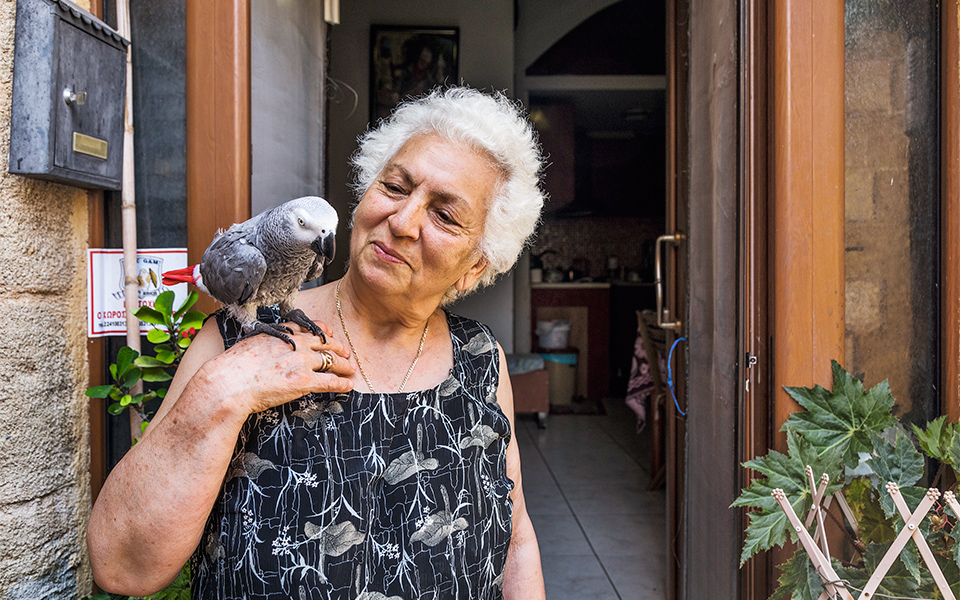
© Perikles Merakos
I don’t need anything, but I find myself ready to start shopping. Expensive jewelry and brand-name bags hang next to gaudy souvenirs, tin suits of armor and tourist sandals. A river of people sweeps me eastward and among the thousands of objects for sale I spot a few stores, including some antique shops, that look like they might be worth a visit. I also spy some Ottoman fountains adorned with carved arabesques.
Sokratous Street ends at Ippokratous Square with its marble fountain, which is always full of pigeons and is the main rendezvous spot in this part of the Old Town. In the narrow streets around here – Miltiadou, Platonos, Evripidou – there are dozens of bars and clubs which at night make the Old Town unrecognizable, even to the point of insult.
On the steps of the Castellania, once the Commercial Court of the Knights and now the Municipal Library, couples flirt, students pass their time and tourists rest. A faceless crowd and countless touts reveal to me the other face of the Old Town, one which I had hoped to avoid but that becomes even more intrusive as I make my way along Aristotelous Street and into Evreon Martyron Square.
Here the restaurant barkers are completely unrestrained as they loudly pitch the specialties of their respective eateries: moussaka, tzatziki, Greek salad. One has enlisted the assistance of a parrot and another is trying to get tourists to promise they will come in the evening. “Do you really believe you’ll get them to come like this?” I ask him. “They always come,” he replies with a laugh.
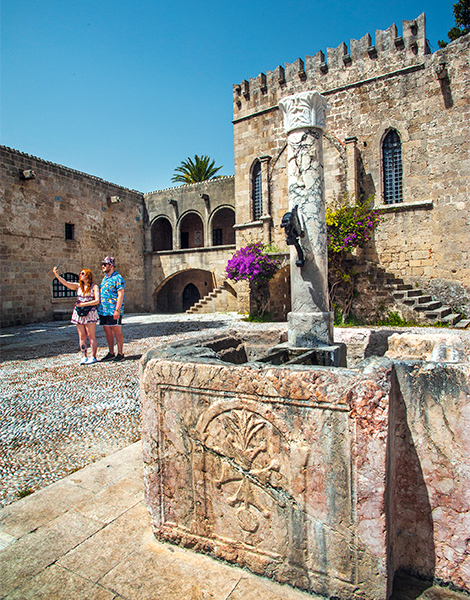
© Clairy Moustafellou
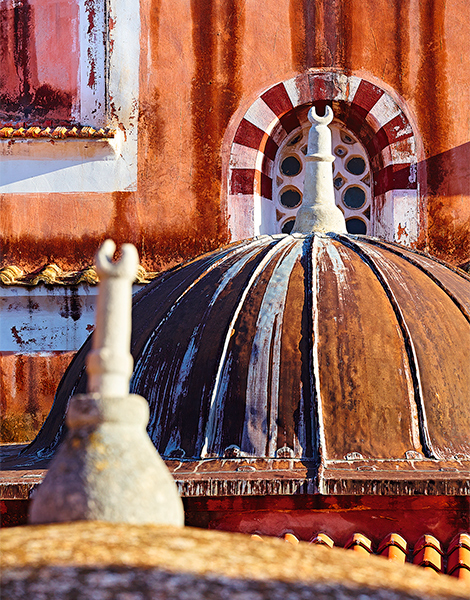
© George Tsafos
LOST IN THE ALLEYWAYS
My suffering ends a few meters further on. I sit down on the steps of Our Lady of the Bourgo, a 14th-century church built in the Late Gothic style, now mostly in ruins. The boys playing football in front of me are bragging incessantly about their favorite team, Diagoras F.C. Fortunately, there is still plenty of Old Town to see. South of Sokratous and Aristotelous streets, life continues at a steady pace, whether there is a cruise ship in the harbor or not, whether it is summer or winter. All you need to do is… get lost.
This is what I do. With no idea where the nearest gate is, I simply stroll along the alleyways. I recognize the Muslim households from the shoes left outside the doors. People greet me with “kalimera,” (good morning) not “moussaka.” Children play in the streets and grandmothers sit on the steps outside their home or in yards filled with flowers, chatting away.
I walk past the Kahal Shalom Synagogue, Byzantine churches, mosques, fountains, brothels and boutique guest-houses – all in one small area. In Arionos Square, I admire the soft curves of the 16th-century Yeni Hamam, where up until a few years ago the locals could enjoy a Turkish bath, just like in the old days; now they’re eagerly awaiting its renovation. The coffee shops under the trees next to the hamam are in no way associated with the unpleasant aspects of mass tourism; in the evening, they turn into high-quality bars with good music and impeccable service.
Still further south, near St. John’s Gate, is the Kokkini Porta Rossa, a quiet boutique hotel that has been open for three years and has helped transform an entire neighborhood previously suffering from a bad reputation. Its owners, Nikos Voulgaridis and his wife Angela, convince me with what they’ve achieved that the Old Town, despite some tourism excesses, is still finding ways to endure and remain magical.

